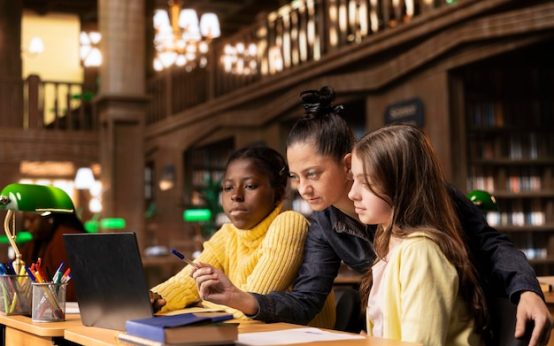Collaboration with parents and specialists is essential for creating supportive educational environments, as it enhances communication, personalizes student support, and fosters community involvement in the learning process.
Neurodiversity in the classroom highlights the importance of recognizing different learning styles. Imagine a place where every student’s unique abilities are embraced. This journey explores how we can make that vision a reality.
Understanding neurodiversity in education
Understanding neurodiversity in education is crucial for creating inclusive learning environments. It refers to the variety of differences in individual brain function and behavioral traits. By recognizing that every student has a unique way of learning, educators can better meet diverse needs.
What is neurodiversity?
Neurodiversity embraces the natural variation in the human brain. It acknowledges that conditions like autism, ADHD, and dyslexia are part of this spectrum. Understanding these differences can help educators support all learners effectively.
Why is it important?
Fostering an understanding of neurodiversity benefits everyone. It promotes a positive classroom culture, reduces stigma, and enhances student engagement. When students feel understood, they are more likely to succeed academically and socially.
- Encourages empathy and understanding among peers.
- Creates a supportive learning environment for all.
- Enhances creativity and problem-solving skills.
Educators can implement various strategies to support neurodiverse learners. For instance, using visual aids and hands-on activities can make learning more accessible. Additionally, offering flexible grouping encourages collaborative learning. Reassessing traditional teaching methods is essential to accommodate diverse learning styles.
Encouraging self-advocacy
Teaching students about their own learning needs fosters self-advocacy. When they understand their strengths and challenges, they can communicate their needs effectively. Educators should encourage open dialogue and help students develop strategies tailored to their requirements.
By building an inclusive classroom, we not only support neurodiverse students but benefit the entire class. Each student’s unique perspective adds value, enriching the educational experience for everyone involved. Ultimately, embracing neurodiversity leads to a more compassionate and effective learning environment.
Benefits of embracing diverse learning styles
Embracing diverse learning styles offers numerous benefits for students and educators alike. Understanding that each student learns differently can lead to a more effective and engaging classroom experience.
Improved Student Engagement
When teaching methods are varied, students are more likely to find methods that resonate with them. This can lead to higher levels of participation and enthusiasm in learning. Engagement is key to retaining information and developing a love for learning.
Enhanced Problem-Solving Skills
Exposure to various perspectives nurtures creativity. When students learn through different styles, they become better problem-solvers. They learn to approach challenges from multiple angles.
- Encourages critical thinking.
- Facilitates collaboration among students.
- Fosters innovation and creativity.
Additionally, recognizing and accommodating different learning styles enhances academic performance. When students can engage with the material in a way that suits their individual learning preferences, they often achieve better results. This inclusive approach can help reduce the achievement gap.
Building Confidence
When students see that their unique way of learning is valued, their confidence grows. This sense of worth translates to a willingness to participate and take risks in their learning. Confidence is particularly vital for students who previously struggled in more traditional learning environments.
Incorporating a range of teaching methodologies leads to a more supportive classroom environment. Teachers can use tools like visual aids, group work, and interactive activities. This approach not only caters to individual needs but also strengthens the classroom community.
Strategies for inclusive teaching

Implementing effective strategies for inclusive teaching is essential in today’s diverse classroom. These strategies help accommodate different learning styles and promote a culture of acceptance.
Utilizing Differentiated Instruction
One key strategy is employing differentiated instruction. This means tailoring lessons to meet varied needs. Teachers can modify content, processes, and products based on students’ abilities.
- Provide multiple forms of content, such as videos, articles, and hands-on activities.
- Adjust the pace of instruction to suit learner needs.
- Allow students to choose how they demonstrate their understanding.
By adopting this approach, educators can ensure that each student remains engaged and learns at their level.
Creating a Supportive Classroom Environment
A supportive environment is crucial for inclusive teaching. Teachers can establish clear classroom rules that promote respect and collaboration. Encourage students to support one another, fostering a sense of community.
Building strong relationships with students also plays a vital role. When students feel close to their teacher, they are more likely to participate and share their challenges. This sense of trust enhances the overall learning experience.
Incorporating Technology
Integrating technology into lessons can greatly benefit neurodiverse learners. Tools like interactive whiteboards, educational apps, and online resources can accommodate various learning styles. For example, visual learners can benefit from videos, while auditory learners might prefer podcasts.
Technology also allows for personalized learning. Many educational platforms enable students to progress at their own pace, which can help mitigate learning gaps.
Regular Assessment and Feedback
Finally, regular assessment and feedback are essential components of inclusive education. Teachers should use formative assessments to gauge understanding and adjust instruction accordingly. Feedback should be constructive and targeted, helping students recognize their strengths and areas for improvement.
These strategies not only aid students with diverse learning needs but also enhance the educational experience for the entire class. By embracing inclusivity, teachers create a thriving learning environment for everyone.
Creating supportive classroom environments
Creating supportive classroom environments is crucial for fostering learning and inclusive education. A welcoming space allows all students to thrive, regardless of their learning styles or needs.
Establishing Ground Rules
Setting clear ground rules helps create a safe space for students. These rules promote respect and kindness, ensuring that every student feels valued. When students know the expectations, they are more likely to concentrate on learning.
- Encourage students to respect diverse opinions.
- Implement anti-bullying measures to protect all learners.
- Promote a culture of collaboration where everyone contributes.
In a supportive environment, students feel comfortable expressing themselves and asking for help. This openness leads to stronger relationships between teachers and students.
Flexible Seating Arrangements
Another important aspect is flexible seating arrangements. Providing various seating options allows students to choose what works best for them. Some may prefer traditional desks, while others might feel more focused at a standing table or on a beanbag chair. Flexible seating caters to different preferences and can positively influence learning.
Additionally, creating areas for group work and quiet study can boost collaboration and individual focus. This variety accommodates the diverse ways that students engage with the material.
Encouraging Social-Emotional Learning
Integrating social-emotional learning (SEL) into everyday lessons enhances classroom support. SEL helps students develop essential skills like empathy, self-awareness, and emotional regulation. When teachers focus on students’ emotional well-being, they create a nurturing atmosphere.
Implementing activities that promote teamwork and understanding can foster deeper connections among students. Group projects, peer mentoring, and class discussions encourage social interaction and help build a supportive classroom community.
Utilizing Positive Reinforcement
Positive reinforcement is another effective strategy. Recognizing and celebrating students’ achievements boosts their confidence. By providing praise and acknowledging effort, educators can motivate students to strive for their best.
Using a rewards system, such as stickers or extra recess time, can also be effective. Celebrating even small successes helps students feel appreciated and encourages a growth mindset.
Collaborating with parents and specialists
Collaborating with parents and specialists is vital for supporting students with diverse needs. By working together, educators can create a comprehensive support system that enhances student learning.
Importance of Communication
Effective communication is key to successful collaboration. Teachers should regularly update parents on their child’s progress and any concerns. This transparency helps build trust and ensures that everyone is on the same page.
- Share insights on what works in the classroom.
- Encourage parents to share their observations from home.
- Organize regular meetings to discuss strategies and progress.
When parents feel informed and involved, they are more likely to engage in their child’s education. This partnership benefits the student’s learning experience.
Engaging Specialists
Involving specialists such as counselors, speech therapists, and special education experts can provide additional support and resources. These professionals can offer valuable insights and strategies tailored to individual learning needs.
For instance, a speech therapist can suggest ways to enhance communication skills, while a counselor can help address emotional challenges. Collaborating with specialists ensures that students receive the appropriate interventions and support.
Creating Individualized Education Plans (IEPs)
One important outcome of collaboration is the development of Individualized Education Plans (IEPs). An IEP outlines specific goals and accommodations for students with learning differences. Teachers, parents, and specialists should work together to create and regularly update these plans.
Regular reviews of IEPs ensure that the strategies remain relevant and effective. This process involves checking on the student’s progress and making adjustments as needed. A collaborative approach helps in creating a flexible plan that meets changing needs.
Building a Supportive Community
Finally, fostering a supportive community is essential. Schools can organize workshops and training sessions for parents to better understand neurodiversity and inclusive practices. This knowledge empowers parents to support their children at home.
Social events can also create connections among families, allowing them to share experiences and strategies. When parents feel part of a community, it enhances their involvement and commitment to their child’s education.
FAQ – Frequently Asked Questions about Collaborating with Parents and Specialists
Why is communication important in collaboration with parents?
Communication is crucial because it keeps parents informed about their child’s progress and any challenges, fostering a strong partnership.
How can specialists contribute to a student’s education?
Specialists provide tailored strategies and insights that address individual learning needs, enhancing the overall support for students.
What is the purpose of an Individualized Education Plan (IEP)?
An IEP outlines specific goals and accommodations for students, ensuring they receive the support necessary for their unique learning requirements.
How can schools build a supportive community for families?
Schools can organize workshops and social events that connect families, empowering them to share experiences and build relationships.

 FreeLearningTools: Unlock Your Potential with These Gems
FreeLearningTools: Unlock Your Potential with These Gems  College Admissions: Understanding the Latest Standardized Testing Changes
College Admissions: Understanding the Latest Standardized Testing Changes  Understanding the Latest Changes in College Admission Tests
Understanding the Latest Changes in College Admission Tests